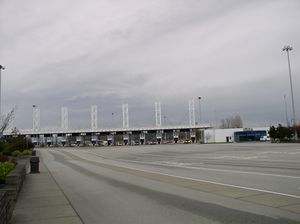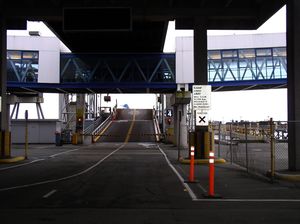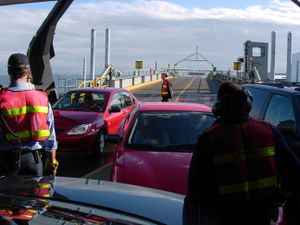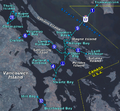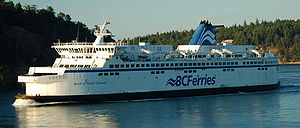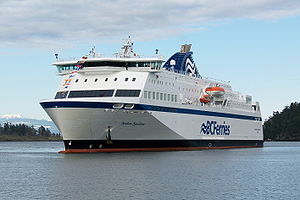BC Ferries
 | |
| Type | Organized as a privately held company, with the provincial Crown as sole shareholder |
|---|---|
| Industry | Transportation |
| Founded | Victoria, British Columbia (1960) |
| Headquarters | Victoria, British Columbia, Canada |
| Key people |
Elizabeth J. Harrison, Chair David Hahn, President & CEO |
| Products | Ferry service |
| Revenue | ▲ C$681.8 million (2009)[1] |
| Operating income | ▼ C$57.6 million (2009)[1] |
| Net income | ▼ C$9 million (2009)[1] |
| Employees | 3,153 (2005) |
| Website | www.bcferries.com |
British Columbia Ferry Services Inc. or BC Ferries (abbr. BCF) is a de facto Crown Corporation that provides all major passenger and vehicle ferry services for coastal and island communities in the Canadian province of British Columbia. Set up in 1960 to provide a similar service to that provided by the Black Ball Line and the Canadian Pacific Railway, which were affected by job action at the time, BC Ferries has become the largest passenger ferry line in North America and the second largest in the world,[citation needed] boasting a fleet of 36 vessels with a total passenger and crew capacity of over 27,000, serving 49 locations on the B.C. coast.
As BC Ferries provides an essential link from mainland Canada to the various islands on its routes, it is subsidized by Transport Canada. The subsidy for 2004-2005 was CAD $25 million[2] and is adjusted annually to keep pace with the rate of inflation. The inland ferries operating on British Columbia's rivers and lakes are not run by BC Ferries. The responsibility for their provision rests with the British Columbia Ministry of Transportation, which contracts operation to various private sector companies.
History
In the late 1950s, a strike by employees of the Black Ball Line caused the Social Credit government of W.A.C. Bennett to decide that the coastal ferry service in B.C. needed to be government-owned, and so he set about creating BC Ferries.
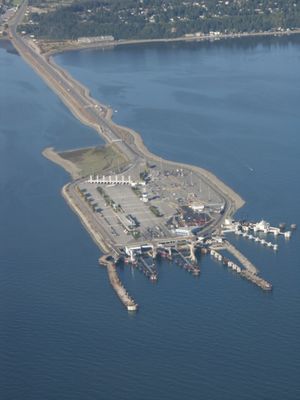
BC Ferries' first route, commissioned in 1960, was between Swartz Bay, north of Sidney on Vancouver Island, and Tsawwassen, a part of the Corporation of Delta, using just two vessels. These ships were the now-retired MV Tsawwassen and the MV Sidney. The next few years saw a dramatic growth of the B.C. ferry system, as it took over operations of the Black Ball Line and other major private companies providing vehicle ferry service between Vancouver Island and the Lower Mainland. As the ferry system expanded and started to service other small coastal communities, BC Ferries had to build more vessels, many of them in the first five years of its operations, to keep up with the demand. Another method of satisfying increasing demand for service was BC Ferries' unique "stretch and lift" program, involving seven vessels being cut in half and extended, and five of those vessels later cut in half again and elevated, to increase their passenger and vehicle-carrying capacities. The vast majority of the vessels in the fleet were built in B.C. waters, with only two foreign purchases and one domestic purchase. In the mid 1980s, BC Ferries took over the operations of the saltwater branch of the B.C. Ministry of Transportation and Highways, which ran ferry services to very small coastal communities. This action dramatically increased the size of BC Ferries' fleet and its geographical service area. The distinctive 'dogwood on green' flag that BC Ferries used between 1960 and 2003 gave the service its popular nickname "the Dogwood Fleet".
At its inception, BC Ferries was a division of the British Columbia Toll Highways and Bridges Authority, a provincial Crown corporation. Through successive reorganizations, it evolved into the British Columbia Ferry Authority, and then the British Columbia Ferry Corporation, both of which, again, were provincial Crown corporations. In 2003, the Government of British Columbia announced that BC Ferries, which had been in debt, was going to be reorganized into a private corporation, implemented through the passage of the Coastal Ferry Act[3] (Bill 18-2003). The single voting share of BC Ferries Corporation is held by the provincial government's BC Ferry Authority, which operates under the rules of the Act.
A controversy began in July, 2004 when BC Ferries, under a new American CEO, announced that the company had disqualified all Canadian bids to build three new Coastal class ships, and only the proposals from European shipyards were being considered. The contract is estimated at $542 million for the three ships, which are each designed to carry 370 vehicles and 1600 passengers.
The argument for domestic construction of the ferries is that it would employ numerous British Columbia workers, would revitalize the sagging B.C. shipbuilding industry, and entitle the provincial government to a large portion of the cost in the form of taxes. However, European shipbuilders had far more experience and shipyards that were more capable of constructing the ships at a significantly lower cost, and contract terms with European shipyards could be negotiated that were superior to what was likely to be available from B.C. shipbuilders.
On September 17, 2004, BC Ferries finally awarded[4] the vessel construction contract to Germany's Flensburger shipyard. The contract protects BC Ferries from any delays through a fixed price and fixed schedule contract, and the performance of the ferries is guaranteed with strong contractual requirements. Coastal Renaissance entered service in March 2008, while Coastal Inspiration was delivered the same month, and entered service in June. The third ship, Coastal Celebration, has been delivered and is now in service as well.
On August 18, 2006, BC Ferries commissioned[5] Flensburger to build a new vessel for BCF's Inside Passage route, with the contract having many of the same types of terms as that for the Coastal Class vessels. The new northern service vessel, Northern Expedition, has been delivered.
Current routes
List
Route numbers are used internally by BC Ferries. All routes allow vehicles unless stated otherwise.
- Route 1 - Georgia Strait South (Highway 17): Swartz Bay to Tsawwassen
- Route 2 - Georgia Strait Central (Highway 1): Nanaimo (via Departure Bay) to Horseshoe Bay
- Route 3 - Howe Sound: Langdale to Horseshoe Bay
- Route 4 - Satellite Channel: Swartz Bay to Saltspring Island (at Fulford Harbour)
- Route 5 - Swanson Channel: Swartz Bay to the Outer Gulf Islands (Galiano, Mayne, Pender, and Saturna Islands)
- Route 6 - South Stuart Channel: Crofton to Saltspring Island (at Vesuvius)
- Route 7 - Jervis Inlet (Highway 101): Earls Cove to Saltery Bay
- Route 8 - Queen Charlotte Channel: Horseshoe Bay to Bowen Island (via Snug Cove)
- Route 9 - Active Pass Shuttle: Tsawwassen to Saltspring Island and the Outer Gulf Islands (listed above in route 5)
- Route 10 - Inside Passage: Port Hardy to Prince Rupert
- Route 11 - Hecate Strait (Highway 16): Prince Rupert to Haida Gwaii (via Skidegate)
- Route 12 - Saanich Inlet: Brentwood Bay to Mill Bay
- Route 13 - Thornbrough Channel: Langdale to Gambier Island and Keats Island (passengers only)
- Route 17 - Georgia Strait North: Powell River (via Westview) to Comox (via Little River)
- Route 18 - Malaspina Strait: Powell River to Texada Island (via Blubber Bay)
- Route 19 - Northumberland Channel: Nanaimo Harbour to Gabriola Island (via Descanso Bay)
- Route 20 - North Stuart Channel: Chemainus to Thetis and Kuper Islands
- Route 21 - Baynes Sound: Buckley Bay to Denman Island (via Metcalf Bay)
- Route 22 - Lambert Channel: Denman Island (via Gravelly Bay) to Hornby Island (via Shingle Spit)
- Route 23 - Discovery Passage: Campbell River to Quadra Island (via Quathiaski Cove)
- Route 24 - Sutil Channel: Quadra Island (via Heriot Bay) to Cortes Island (via Whaletown)
- Route 25 - Broughton Strait: Port McNeill to Alert Bay (on Cormorant Island) and Sointula (on Malcolm Island)
- Route 26 - Skidegate Inlet: Skidegate (on Graham Island) to Alliford Bay (on Moresby Island)
- Route 30 - Mid-Island Express (Highway 19): Nanaimo (via Duke Point) to Tsawwassen
- Route 40 - Discovery Coast: Port Hardy to Bella Coola (with stops at Bella Bella, Shearwater, Ocean Falls and Klemtu)
Maps
Numbers in blue circles are ferry route numbers. Provincial highway trailblazers are added where appropriate.
- BC Ferries Zone Two.png
Zone 2 - Central Georgia Strait
- BC Ferries Zone Three.png
Zone 3 - Northern Georgia Strait
- BC Ferries Zone Five.png
Zone 5 - North Coast
Regional districts served
Fleet
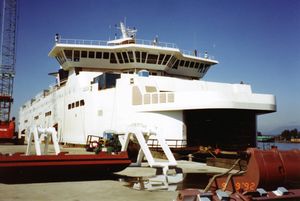

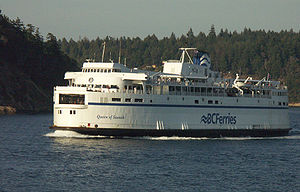
BC Ferries has the largest fleet of vehicle ferry vessels in the world. There are 36 vessels, ranging from small 16-car ferries up to 470-car "superferries". All of the vessels in use by BC Ferries are "roll-on, roll-off" car ferries. Most of the major vessels are based on similar designs which are aggregated into "classes" of ferries:
Current Vessels
- 2 Spirit class vessels. Also known as "Superferries", the largest in the fleet.
- 3 Coastal class vessels. The largest double-ended ferries in the world, introduced in 2008.
- 5 Cowichan Class. BC Ferries' original double-ended "Jumbos".
- 2 Burnaby class. Built in the 1960s, these ferries have been stretched to increase their capacity.
- 3 Intermediate class vessels.
- 1 Century class vessel.
- 3 Powell River class ships.
- 2 Q class ships.
- 2 T class ships.
- 4 K class ships
- 2 N class vessels, the smallest in the fleet.
- MV Nicola (Owned, but not operated by BC Ferries)
- MV Nimpkish
- 8 unclassed vessels
- MV Northern Expedition
- MV Queen of New Westminster
- MV Northern Adventure
- MV Queen of Chilliwack
- MV Howe Sound Queen
- MV North Island Princess
- MV Quadra Queen II
- MV Mill Bay
Former Vessels
Accidents
| |
This section needs additional citations for verification. Please help improve this article by adding reliable references. Unsourced material may be challenged and removed. (October 2009) |
| 40px | This section's representation of one or more viewpoints about a controversial issue may be unbalanced or inaccurate. Please improve the article or discuss the issue on the talk page. |
The following is a summary of some of the incidents which have occurred in the BC Ferries fleet:
Queen of Victoria
On August 2, 1970 the Soviet freighter Sergey Yesenin collided with the Queen of Victoria in Active Pass, slicing through the middle of the ferry, days after her return to service following stretching. Three people were killed and damage was estimated at over $1 million (1970) dollars. The Soviet ship was not supposed to be in Active Pass, and as such, the Soviet government was forced to compensate BC Ferries.
Years later, while in Active Pass and within metres of the site of the 1970 collision, the Queen of Victoria was disabled by a fire in the engine room.
Queen of Alberni
On August 9, 1979, the Queen of Alberni was transiting through Active Pass when it ran aground on Galiano Island, tipping fifteen degrees to starboard. Several large commercial vehicles on board the vessel at the time were damaged. No persons were injured, but a racehorse on board was killed.
On June 1989, the Queen of Alberni collided with the loading dock at Departure Bay causing significant damage to the ship and dock. 6 people were injured including a cook who suffered a fractured cheekbone as he was walking down a set of stairs.
On March 12, 1992, at 8:08 am (16:08 UTC), the Queen of Alberni collided with the Japanese freighter Shinwa Maru southwest of Tsawwassen. The collision occurred in heavy fog, with both vessels suffering minor damage. Injuries included 2 serious and 25 minor injuries for the 260 people on the ferry, while none of the 11 people aboard the freighter received injuries.[6]
Queen of Cowichan
On August 12, 1985 three people were killed when the Queen of Cowichan ran over a pleasure boat near the Horseshoe Bay terminal.
Queen of Saanich
On the morning of February 6, 1992 the Queen of Saanich and the Royal Vancouver passenger ship collided in heavy fog while navigating near the northern entrance of Active Pass. A total of 23 passengers aboard the Royal Vancouver were injured. Blame was cast upon the crew of the Royal Vancouver for failing to track the Queen of Saanich on radar, though both vessels were equipped with sophisticated radar systems.
Queen of New Westminster
In October, 1971, the Queen of New Westminster pulled out of her berth at the Departure Bay terminal while vehicle loading was in progress. A car and its two occupants fell into the water. Both of the vehicle's occupants were rescued.
In a similar incident, on August 13, 1992 the same vessel pulled out of her berth at the Departure Bay terminal while vehicle loading ramps were still lowered and resting on the ship. Three people were killed, one was seriously injured, and two others received minor injuries when a van from Alberta containing 6 people fell 15 m (about 50 ft) from the upper deck onto the lower car deck and finally into the sea below. The van was stopped and instructed to wait on the loading ramp by terminal crew members. The Transportation Safety Board of Canada determined that this accident was caused by the vessel not properly following departing procedures and secondarily due to poor communication between terminal and ship crew members.[7]
Mayne Queen
On November 7, 1995 the Mayne Queen departed from Snug Cove and ran into a neighbouring marina, heavily damaging a floating dock in addition to 12 small pleasure boats (one of which sank). The crash was primarily attributed to human error and while transferring steering and power control from one control panel to the other located in the ship. The captain of the vessel was also inexperienced with the Mayne Queen and normally piloted other vessels. More alarming was the fact that the captain promptly left the scene of the accident after the incident occurred without conducting a proper damage assessment.[8]
On August 12, 1996 the Mayne Queen departed Swartz Bay terminal and ran aground off Piers Island after losing steering control. The grounding occurred while performing a regular weekly test of the batteries for the steering control system. A crew member overheard there was going to be a test and in an attempt to be helpful and without direction cut all power from the vessel's steering batteries as he had done at night when the ship was stored, not realizing the test in question only required the removal of a battery charger and that his assistance was neither requested nor required. No one was injured in the incident and the vessel was assisted off the rocks at high tide but she suffered extensive damage to her propulsion system, having two of the four steering and propulsion pods for the right-angle drives sheared off and one of the two remaining pods suffering propeller damage.[9]
Spirit of Vancouver Island
On September 14, 2000 the Spirit of Vancouver Island collided with the 9.72 m (about 32 ft) Star Ruby while attempting to overtake the vessel in a narrow channel. The collision occurred approximately 1 km (about ½ mi) from the Swartz Bay Terminal where the ferry had departed from. The Spirit of Vancouver Island struck the Star Ruby on its port side, causing the pleasure craft to flip over and eventually right itself, though swamped and heavily damaged. Two passengers aboard the Star Ruby later died as a result of their injuries sustained by the collision.[10]
On July 13, 2003, the Spirit of Vancouver Island collided with the dock at Swartz Bay. Four passengers suffered minor injuries. The accident caused tens of thousands of dollars of damage to the dock and the ship.
On October 9, 2009, a standby generator on the Spirit of Vancouver Island caught fire on an early morning sailing out of Swartz Bay Ferry Terminal. No one was injured in the incident however it did cause massive delays in the ferry system because of the already large volume of traffic for Thanksgiving weekend. Eight sailings were cancelled that day and the ship remained out of service for the entire weekend.[11]
Queen of Surrey
On May 12, 2003 the Queen of Surrey was disabled as a result of an engine room fire. The Queen of Capilano was dispatched and tethered to the Queen of Surrey while tugboats were dispatched. The vessel was then towed back to shore. None of the 318 passengers were injured, but several crew members were treated for minor injuries. Some buckling of the main car deck resulted from the heat of the fire. However, no vehicles were damaged in the incident.[12]
Queen of Oak Bay
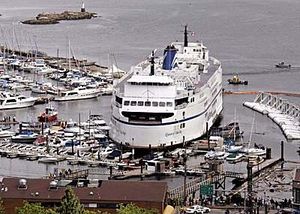
On June 30, 2005 at about 10:10 in the morning (17:10 UTC), the vessel Queen of Oak Bay, on the Nanaimo to Horseshoe Bay (or Trans-Canada Highway) ferry route, lost power four minutes before she was to dock at the Horseshoe Bay terminal. The vessel became adrift, unable to change speed, but able to steer with the rudders. The horn was blown steadily and an announcement telling passengers to brace for impact was made minutes before the 139 m (456 ft) ship slowly ran into the nearby Sewell's Marina, where she destroyed or damaged 28 pleasure craft and subsequently went aground a short distance from the shore. No casualties or injuries were reported. [13] [14] [15]
On July 1, 2005, BC Ferries issued a statement that Transport Canada, the Transportation Safety Board, and Lloyd's Register of Shipping were reviewing the control and mechanical systems onboard to find a fault. An inspection revealed minimal damage to the ship, with only some minor damage to a metal fender, paint scrapes to the rudder, and some minor scrapes to one blade of a propeller.
On July 7, 2005, BC Ferries concluded that a missing cotter pin was to blame. The pin normally retained a nut on a linkage between an engine speed governor and the fuel control for one of the engines. Without the pin, the nut fell off and the linkage separated, causing the engine, clutches, and propellers to increase in speed until overspeed safety devices tripped and shut down the entire propulsion system. The faulty speed governor had been serviced 17 days before the incident during a $35-million upgrade and the cotter pin was not properly replaced at that time.
The Queen of Oak Bay was quickly repaired and tested at sea trials. She returned to regular service on July 8, 2005. A complete investigation report consisting of a 14-page Divisional Inquiry and a 28-page Engineering Incident Investigation was finally released in September 2006.[16]
The Transportation Safety Board's Marine Investigation Report, released on September 6, 2007, indicated that "inadequacies in BC Ferries' procedures on safety-critical maintenance tasks and on ship handling during berthing operations" were major contributing factors to the accident. It appears that insufficient oversight of work done by contractors also played a role in the accident.
Queen of the North
On March 22, 2006 the M/V Queen of the North sank 135 km (81 mi, 70 nautical miles) south of Prince Rupert, British Columbia when she struck Gil Island at approximately 1 a.m. PST. Two people from 100 Mile House went missing. David Hahn, CEO of BC Ferries states, "There is a real possibility that they went down with the ship." It is unlikely that it will be possible to salvage the North.
Officials have determined the cause of this accident is due to human error by 3 BC Ferries employees neglecting their navigational duties. Charges are being considered of Criminal Negligence Causing Death, and a Class Action Lawsuit for the passengers is proceeding while the Ferry and Marine Union seeks to re-instate the fired crew who failed to provide information to the $1 million TSB enquiry.[17]
Quinsam
On January 9, 2007, the MV Quinsam was loading traffic from Nanaimo to Gabriola Island when the ferry unexpectedly pulled out of its berth. A pickup truck that was on the boarding ramp plunged into the water below. Ferry workers were able to warn the truck's lone occupant, who was able to escape before the vehicle fell.[18]
See also
- Alaska Marine Highway - Alaska's Marine Highway System, similar to BC Ferries. Also serves Prince Rupert.
- Black Ball Line
- Barnston Island Ferry - a ferry operated by the BC Ministry of Transportation
- British Columbia Ministry of Transportation - responsible for the ferries on the lakes and rivers of the B.C. Interior.
- Fast Ferry Scandal - information about the Pacificat class of vessels that BC Ferries briefly operated.
- Georgia Strait Bridge - a controversial idea of replacing the ferry service with a fixed link between Vancouver Island and the British Columbia mainland.
- Kootenay Lake Ferry - a ferry in the British Columbia interior operated by the BC Ministry of Transportation
- Marine Atlantic - An east-coast analogue of BC Ferries.
- Washington State Ferries
- Inter-Island Ferry Authority
Shipyards
- Victoria Machinery Depot
- Burrard Dry Dock
- Allied Shipbuilders Ltd.
- Yarrow Shipbuilders
- Washington Marine Group - Originally called the Vancouver Shipyards Co. Ltd
- Vancouver Shipyard
References
- ↑ 1.0 1.1 1.2 "BC Ferries Releases Year-end Results" (PDF). 2009-06-11. pp. 4. http://www.bcferries.com/bcferries/faces/attachments?id=108870. Retrieved 2009-06-13.
- ↑ Vancouver Sun article (see last paragraph for subsidy information)
- ↑ Legislative Assembly of British Columbia
- ↑ Microsoft Word - 04-071 Super C.doc
- ↑ http://www.bcferries.com/news/files/06-049contracttobuildnewnorthernvessel.pdf
- ↑ Canadian Transportation Safety Board report on Shinwa Maru/Queen of Alberni collision
- ↑ Canadian Transportation Safety Board report on Queen of New Westminster accident
- ↑ Canadian Transportation Safety Board report on 1995 Mayne Queen accident
- ↑ Canadian Transportation Safety Board report on 1996 Mayne Queen accident
- ↑ Canadian Transportation Safety Board report on Spirit of Vancouver Island accident
- ↑ CBC News Report on the incident.
- ↑ Canadian Transportation Safety Board report on Queen of Surrey engine fire
- ↑ "B.C. ferry runs aground in West Vancouver, hits marina and boats". The Seattle Times. 2005-06-30. http://seattletimes.nwsource.com/html/travel/2002353141_webbcferry30.html.
- ↑ "B.C. ferry that hit marina 'just kept coming'". CBC News. 2005-07-01. http://www.cbc.ca/canada/story/2005/06/30/ferry-050630.html.
- ↑ Queen of Oak Bay Collision Simulator
- ↑ BC Ferries Corporation (September 25, 2006). Queen of Oak Bay Grounding at Sewell’s Marina: Divisional Inquiry and Engineering Incident Investigation.
- ↑ BC Ferries: Divisional Inquiry
- ↑ Truck rolls into harbour when Nanaimo ferry leaves dock early
- Bannerman, Gary and Patricia. The Ships of British Columbia - An Illustrated History of the British Columbia Ferry Corporation. Surrey: Hancock House Publishers, 1985
Press releases
- BC Ferries Corporation (June 13, 2005). Upgraded Queen of Oak Bay Returns to Service. Press Release.
- BC Ferries Corporation (June 30, 2005). Queen of Oak Bay Loses Power and Runs Aground. Press Release.
- BC Ferries Corporation (June 30, 2005). Update on Queen of Oak Bay Grounding Incident. Press Release.
- BC Ferries Corporation (July 1, 2005). Investigation into Queen of Oak Bay Incident Continues. Press Release.
- BC Ferries Corporation (July 3, 2005). BC Ferries to Meet with Horseshoe Bay Boat Owners. Press Release.
- BC Ferries Corporation (July 5, 2005). Queen of Oak Bay to Undergo Extensive Sea Trials. Press Release.
- BC Ferries Corporation (July 7, 2005). Preliminary Investigation into Queen of Oak Bay Incident Released. Press Release.
- BC Ferries Corporation (March 22, 2006). Queen of the North grounded and sank. Press Release.
External links
| BC Ferries
]]- BC Ferries Official Site
- BCF Vessel Tracking - realtime vessel positions
- West Coast Ferries
- BC Ferry & Marine Workers Union
- Martin Crilly, Commissioner of BC Ferries
- BC Ferries and Ships on the BC Coast (very extensive photo galleries)
| ||||||||||||||||||||||||||||||||||||||
de:BC Ferries es:B.C. Ferries fr:British Columbia Ferry Services no:BC Ferries zh:卑詩渡輪
- Pages with broken file links
- All articles with unsourced statements
- Articles with unsourced statements from October 2009
- Articles with invalid date parameter in template
- Articles needing additional references from October 2009
- All articles needing additional references
- Articles needing more viewpoints
- BC Ferries
- Transportation in Greater Vancouver
- Companies established in 1960
- Crown corporations of British Columbia
- Coast of British Columbia
- British Columbia political scandals
